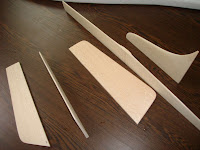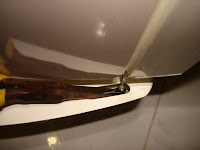One thing great about slope is there are so many flying types and planes available, speed, scale, thermal, etc. One type that is getting popular particularly in the US, Europe is slope aerobatics.I not talking about the basic rolls and loops, i meant 3D style aerobatics - flat spins, snap rolls, blenders, rolling circles and even Knife edge, yes knife edge.
Do that at the slope, close in your face and you have what the French called Voltige Très Près du Relief (VTPR) which, loosely translated, is "aerobatics really close to the ground". This minitoon
video will give an insight what VTPR is about.
It has been great fun doing close range stuns with the Weasel and i wanted more, enter Le Fish! . Inspired in equal parts by fullscale aerobatics gliders, the French VTPR phenomenon, and the desire for an EPP glider capable of unlimited aerobatics performance, Le fish is original design by American Steve Lange.
This plane is directly inspired by the MiniToons, the Voltij, and all the other very cool French aerobatic gliders that share a similar "fish" design. Steve has partnered Jack at
www.leadingedgegliders.com and made this plane available to all as a kit. He also has a cool site at
www.slopeaerobatics.com with some great videos. Got poisoned by those videos, and clicked the order button. Ops...
Here's the kit. A set of EPP wing cores, EPP fuslage, CF spars, balsa tail bits, misc hardware. I plan to build it light as possible as our slope conditions are not that great although we do get the occasional huge lifts, also the slope is slanted at a gentle angle and does not generate those vertical lifts that are great to perform VTPR.

Balsa tail bits

Misc hardware

Wing cores came with pre-cut slots for the CF spars

Glue that works well with EPP is Goop. Its a very strong contact adhesive which remains flexible when dried. One caution make sure area is well ventilated as Goop gives off not-so-nice vapours as it dries.

Glue the wings together with Goop and wait for it to dry.

Goop in the 2 CF spars and place the wings on the wing beds to ensure they are straight n true.

Stack weights on the wing beds while the Goop dries

Some parts of the CF spars didn't contact well with the wings so used thin CA and flooded the gaps. After its dried, glue on the hard wood trailing edge and balsa TE.





















































